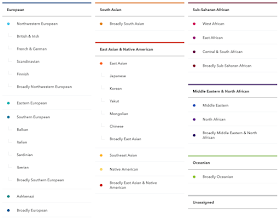 |
| My new sub-regions from 23andMe |
My initial feelings on 23andMe's new sub-regions are that although they have fewer of them than AncestryDNA's 300+ Genetic Communities, it does seem as though one is more likely to get sub-regions at 23andMe than they would be to get GC's from AncestryDNA. 23andMe correctly identified that my "British & Irish" results are actually from the UK, and my Scandinavian results are from Norway. I also have a sub-region of "Italy" under my existing "Italian" results (see left) - that probably sounds rather obvious, but when you look at the list of all sub-regions, you see that there's also an available sub-region of Malta listed under "Italian" - so once again, they've correctly identified my Italian ancestry and not mistaken it for Maltese.
 |
| No European GC's at AncestryDNA |
It is a little bit of a shame 23andMe weren't able to identify my German ancestry, separate from France and other sub-regions in this group. So far, LivingDNA were the only ones to accurately accomplish this, and it was with percentages.
If you click on "See all tested populations" at the bottom of your 23andMe Ancestry Composition, you'll be able to see that each sub-region, although having no percentage, does show how strongly you match that group with a 5 dot system (shown below). The more dots, the more strongly you match that population. Only if you have 2 or more dots does the group show up on your Ancestry Composition page, but when you click on "See all" you may find you match additional groups with only 1 dot. For example, I have 1 dot for Sweden, but I have no Swedish ancestry and because it's only 1 dot, it doesn't show on my Ancestry Composition unless I click "See all". My existing sub-regions for Italy, United Kingdom, and Norway each have 2 dots, which is why they all show up on my Ancestry Composition page.
 |
| Dots showing the strength of my connection to these groups |
 |
| My previous 23andMe results for comparison |
Here's a complete list of the new sub-regions:
 |
| Original 23andMe's populations for comparison |
- European
- Italian
- Italy, Malta
- French & German
- Austria, Belgium, France, Germany, Luxembourg, Netherlands, Switzerland
- British & Irish
- United Kingdom, Ireland
- Scandinavian
- Norway, Sweden, Denmark, Iceland
- Iberian
- Portugal, Spain
- Sardinian
- Balkan
- Albania, Bosnia and Herzegovina, Bulgaria, Croatia, Greece, Macedonia, Moldova, Montenegro, Romania, Serbia
- Finnish
- Eastern European
- Belarus, Czech Republic, Estonia, Hungary, Latvia, Lithuania, Poland, Russia, Slovakia, Slovenia, Ukraine
- Ashkenazi Jewish
- Broadly Northwestern European
- Broadly Southern European
- Broadly European
- Western Asian & North African (formerly Middle Eastern & North African)
- North African & Arabian (formerly North African)
- Algeria, Bahrain, Egypt, Jordan, Kuwait, Libya, Morocco, Saudi Arabia, Tunisia, United Arab Emirates, Yemen
- Western Asian (formerly Middle Eastern)
- Armenia, Azerbaijan, Cyprus, Georgia, Iran, Iraq, Lebanon, Syria, Turkey, Uzbekistan
- Broadly Western Asian & North African
- Sub-Saharan African
- West African
- Cabo Verde, Cameroon, Ghana, Liberia, Nigeria
- East African
- Eritrea, Ethiopia, Kenya, Somalia, Sudan
- African Hunter-Gatherer (formerly Central & South African)
- Broadly Sub-Saharan African
- South Asian
- Broadly South Asian
- Afghanistan, Bangladesh, India, Mauritius, Nepal, Pakistan, Sri Lanka
- East Asian & Native American
- Japanese
- Korean
- North Korea, South Korea
- Siberian (formerly Yakut)
- Manchurian & Mongolian (formerly Mongolian)
- Kazakhstan, Kyrgyzstan, Mongolia
- Chinese
- Hong Kong, Mainland China, Taiwan
- Southeast Asian
- Cambodia, Guam, Indonesia, Laos, Malaysia, Myanmar, Philippines, Singapore, Thailand, Vietnam
- Native American
- Argentina, Aruba, Belize, Bolivia, Brazil, Chile, Colombia, Costa Rica, Cuba, Dominican Republic, Ecuador, El Salvador, Guatemala, Honduras, Mexico, Nicaragua, Panama, Paraguay, Peru, Puerto Rico, Uruguay, Venezuela
- Broadly East Asian
- Broadly East Asian & Native American
- Melanesian (formerly Oceanian)
- Broadly Melanesian
- American Samoa, Fiji, Samoa, Tonga
You can also view a list of populations available from each DNA company here and see how 23andMe compares with other companies.

This new feature's results were fascinating. 23andMe shows that I have 13.1% East Asian and Native American DNA. Two of the sub-regions have five dots: Colombia and Cuba. There's a few more sub-regions with dots, but the highest rated are Colombia and Cuba. My mom is from Colombia and my dad is from Cuba.
ReplyDelete